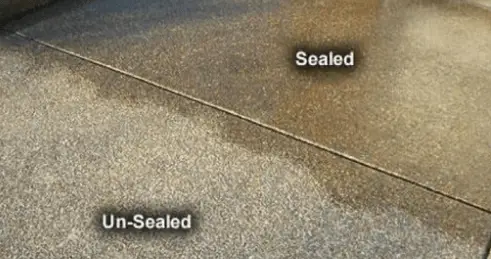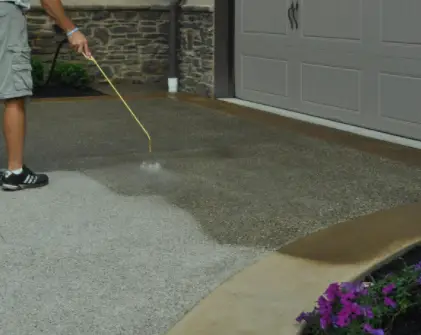Have you grown tired of the unsightliness of your faded concrete patio? Looking for a good concrete sealer to facilitate your patio maintenance routine? Well, your search ends with us.

Below, we’ve drawn up a detailed guideline with all the information you need to know about sealing concrete patios; including when to do it, how to do it, and how much it should cost you should you opt to contract professional services.
Should you Seal Concrete patio?
Yes, you should! Despite not being exposed to heavy vehicle traffic like concrete driveways, concrete patios are still vulnerable to wear, which dampens the visual aesthetic they’re meant to provide.
Whether its barbecues, regular foot traffic, or solar exposure; several factors can combine to dim the beauty of your once beautiful patio. Patio sealing also serves to safeguard your stained concrete patio from absorbing moisture, fading and getting old.
Most patio sealer brands contain UV protectants, thus protecting your patio from fading due to solar exposure. This is especially useful for stamped concrete patios which are usually enhanced aesthetically by surface decoration. On top of their anti-fading properties a sealer also help bring out the color in your concrete.
If you have a patio that’s stamped to resemble the rustic appearance of weathered stone, you can trust a chemically reactive patio sealer to get the job done without any negative impact on the weathered design, as it would soak right into the concrete.
And it’s not just existing concrete patios that could use some sealing, new ones- too- can be sealed. However- make sure to let your new concrete patio dry out for at least four weeks before sealing, as concrete sealers are typically applied on dry surfaces.
How often do you seal concrete patio?

You may have seen a few commercials advising you to buy and apply their brand of concrete sealer to your patio or driveway every year.
However, this is usually an exaggeration from the home improvement companies behind the ads.
While you won’t have to seal your concrete patio annually, applying an efficient sealer every couple years should help make your concrete slab stronger and get rid of any etching.
If you live in a region that experiences snowy winters with freeze-thaw cycles, sealing your concrete patio during fall will help safeguard it from freeze-thaw damage in winter.
For the first time you sealed your concrete patio- you might have failed to undertake surface profiling to establish whether your concrete patio is porous enough to properly soak and adhere onto the surface.
If this is the case and you have a tight concrete surface, you might have to apply a sealer more frequently as it won’t take long before it starts flaking off.
Sealing Concrete Patio – Steps

To seal your concrete patio, first off, you need to prep the patio surface to ensure the sealer will effectively stick to the concrete.
Prepping the surface includes getting rid of any dirt, oil, and grease coatings on your patio.
How thorough you should clean depends on whether it’s a new or existing patio. For new ones, minimal prepping is required. However, for existing patios with dirt that has accumulated over time, we recommend the use of a pressure washer to effectively remove all dirt from the surface.
Additionally, if your surface was machine-troweled for a smoother, tighter finish; you may need to acid-etch or light sand it to open it up and allow for sealers to stick better after application.
After prepping the surface, it’s now time to apply the patio sealer. This can be done using a range of tools including paint rollers and pump-up sprayers. We recommend the use of the former for water-based sealers, while solvent-based sealers are best applied using pump-up sprays.
For stamped/textured concrete patios, rollers with thicker naps do a better job at getting into the patterned depressions. You can also combine both sealer application methods, starting with spraying then reverse-rolling, so as not to allow the sealer to settle in low spots.
Take care not to apply an overly thick layer of patio sealer, as it’ll just settle atop the concrete rather than soak into it. The standard practice is to apply no more than two layers for a more even spread.
It’s also advisable to adhere to the manufacturer’s guidelines on the product labelling for your particular brand of concrete patio sealer.
How much does it Cost to Seal a Concrete Patio?
If you’re not a DIYer, the cost of sealing your concrete patio will largely depend on its size and how much prepping goes into the process before sealing begins.
For instance- according to howmuch.net, to seal about 500-square foot of an acrylic concrete surface costs approximately $684, which translates to about $1.4 per square foot.
Meanwhile, according to homewyse.com, the cost of applying Polyutherane Concrete Sealer begins at $1.18 per square foot.
What are the types of concrete Sealers?
The two types of sealers recommended for concrete include:
1. Acrylic sealers
Acrylic sealers are the best for decorative interior and outdoor concrete works such as floors, concrete patio, driveways and walkways. They are available in solvent and water based formulations. Acrylic sealers provides effective protection against water and salts intrusion while allowing moisture to escape from the slab.
These types of sealers are known to be UV resistant and stays long time without yellowing. The wide range of sheen levels of these sealers can be used to give a gloss to colored and exposed-aggregate concrete.
2. Penetrating sealers
A penetrating sealer is the best alternative if you prefer a natural looking surface. They are made to penetrate a concrete through pores to form a chemical bond that limit moisture intrusion and deicing salts and chemicals.
Penetrating sealers provides protection while maintaining the natural appearance of the concrete. They are the best for outdoor concrete flatworks due to their excellent protection against harsh environmental conditions.
Unlike acrylics and polyurethane sealers that leave a glossy film, penetrating sealers are the most suitable for concrete driveways, walkways and patio where traction is important.
The type of sealer you want to purchase will depend with the decorative nature of the concrete, the finish you want to achieve and your budget.
How long do Concrete Sealers last?
The average lifetime of a good quality sealer is typically three to five years, after which it starts to wear away, regardless of whether the surface is well-profiled or not.
The exact lifetime varies from patio to patio due to varying levels of exposure and usage, including foot traffic. You may be wondering- then- how you can know when it’s time to reseal your concrete patio.
Well, there’s a few tell-tale signs to look out for: the patio surface losing its sheen, water soaking into the concrete rather than pooling up atop the surface, and the surface finish gradually turning into an unsightly color. If any of this is happening to your concrete patio, it’s time to apply a new coat of seal!
When is the best time to apply a sealer?
The season you pick and how you prepare your concrete will determine the performance and durability of your sealer. Always consider the nature of the surface, prevailing weather conditions and time you allow for the sealer cure.
A new concrete should be allowed at least one month to cure completely before application of the sealer. Old and worn out surface must be cleaned and be repaired before the sealing process. The patio, driveway or sidewalk you are about to seal should be clean and dry.
The temperature of the day is also an important factor. Sealers cure properly when the temperature is between 50 to 90 degrees Fahrenheit. The area you are dealing with should be blocked from any traffic for around 3 days until the sealer has properly cured.
When should you reseal a Concrete patio?
Even the most durable sealer will wear away with time. The exact time for this depends with the usage, amount of traffic, weather and the stipulated life time of the sealer. Resealing is usually done averagely after 3 to 5 years to reinstate the concrete protection and preservation of its appearance.
It is easy to tell if your patio or driveway needs a new coat of sealer. If the surface sheen is lost, the finish looks worn out and when water soak instead of beading, then it’s the right time to reseal.
Before you start the resealing process, give the concrete and thorough cleaning and let it dry. Follow by application of a light layer of the same sealer you used before. If you are changing to a different brand, you will have to remove any traces of the previous product.